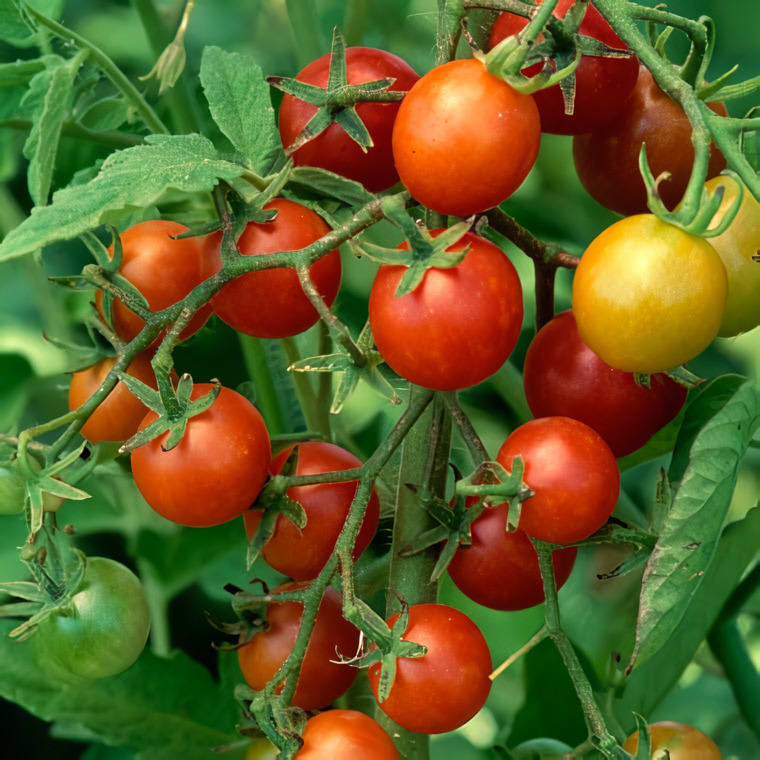This popular garden veggie can be a challenge to grow. We’ll fix that. Tomatoes are like Goldilocks — they want everything to be just right. Mess up soil, sun, and water conditions just a little, and your tomatoes succumb to rot, spots, and wilt.
Soil Prep is a Must
Tomatoes thrive in well-drained soil, so fix your soil before planting. Both sandy soil (drains too quickly) and clay soil (drains too slowly) can become tomato-friendly soil by adding decayed organic matter — dried leaves, grass clippings, compost from your pile — and by turning cover crops, such as annual ryegrass — into the soil 2-3 weeks before planting.
Tomatoes thrive in slightly acidic soil — pH 6.0 to 6.8. Test your soil and if it’s too acidic, add pulverized lime; if it’s too alkaline, add a sulfur acidifier (follow application directions on the package). These additives will burn young plants, so fix the chemical composition of your soil 6-12 months before planting. If you haven’t done that, and your soil needs to be more acidic, fertilize with a nitrogen-rich fertilizer, animal manure, or fresh, diluted human urine (10 parts water: 1 part urine). Then remember to fix your soil next fall.
Here’s why you should use an expert to test your soil. Here’s how to fix your soil.
Location, Location, Location
Tomatoes are sun worshipers and require full sunlight, at least 6 hours per day; more is better. The south side of your property is a likely candidate for maximum sunshine. Plants also like protection from strong wind and plenty of space to grow. A tomato plant easily can reach 6 ft. high and 4 ft. wide, so make sure you have a large, open space in your garden to devote to tomatoes. Depending on the variety, space seeds or seedlings between 1 ft. (dwarf varieties) and 4 ft. (big boys) apart.
Planting Pointers
Plant tomato seedlings as soon as your garden soil reaches 65-70 degrees F. (check with a soil thermometer, $10-$25). If you have a long growing season, stagger your planting over 4-6 weeks, which will reduce bug and blight issues and will allow you to harvest fruit throughout the summer.
Dig a hole deep enough to cover roots and stems up to the lowest leaves. Add to the hole 1 cup of kelp meal and 1 cup of bone meal, which act as slow-release fertilizers that aid blossom and fruit growth.
Staking Well Done
There’s no one correct way to stake a tomato plant. Some folks love to tie drooping branches to wood or bamboo stakes (green alternative). Other options: steel tomato towers ($25 for a steel tower 53 inches high); or DIY tomato cages from low-cost fence wire or concrete reinforcing wire.
Remember the goal is to keep branches and fruit from dragging on the ground, where they are vulnerable to disease and infestation. If you use ties, tie them loosely around branches, which will prevent cutting tender stems.
Water Wisely
Like most garden plants, tomatoes need about 1 inch of water per week to grow strong and tall. But these are not feast-or-famine growers; if you make the rookie mistake of letting the soil dry out and then flooding it with water, the fruit will likely split.
Instead, tomatoes want the soil to be dependably moist. They love drip hoses and ollas that supply steady water to roots; they don’t like pulsating sprays that smack tender stalks and wet foliage, making them more prone to fungus.
Here are three DIY watering systems you can make yourself.
Tried and True Tomato Tips
-
Cut old pantyhose into strips to use as stake ties. They won’t cut into tender stalks, are easy to tie, and will last more than one season.
-
To prevent blossom rot — ugly brown patches on the bottom of fruit that result from a calcium deficiency — mix ground eggshells into the soil, or place an antacid tablet in your planting hole.
-
Rotate the location of your tomato crop each year, which will cut down on pest and disease problems and allow soil to replenish nutrients.
-
Even if you buy tomato seedlings from an outdoor nursery, it takes about a week to harden off (acclimate) the plants before putting them in the ground. Increase daylight exposure by 2 hours per day, gradually moving the plants from shade to full sun.
-
Transplant seedlings on cloudy days when they are less likely to dehydrate.





